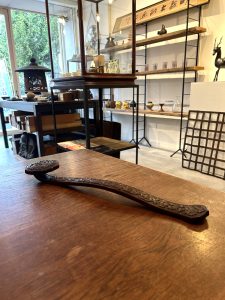如意、孫の手、正倉院…(愛知県名古屋市千種区姫池通 骨董買取 古美術風光舎)
2025.11.05

店内に飾られている如意(にょい)が気になりまして調べてみました。
元々は僧侶が読経や説法をする際に手に持ち、威儀を正したといわれる法具です。如意の形は、あの背中を掻く時に便利な「孫の手」に由来するとされています。古式の如意の掌は手指のような形をしていましたが、雲形、笏形など様々な形へと変化していきました。ただ「孫の手」がどういう経緯で「法具」に転用されたのか興味深いところです。もしや読経の途中で背中が痒くなった時に使っていた?などと下世話な想像しかできませんが、如意という言葉が「思いのままに」「自由自在に」という意味をもつことから仏教の教えと関係しているのかもしれません。
如意と聞くと中国の明時代のお話「西遊記」の中で孫悟空が手に持つ長い「如意棒」を思い浮かべてしまうのですが、物語の中で如意棒の長さは5m30cm、重さは8トンとされているそうです。普段は小さく縮めて耳の中に納め、必要に応じて取り出して使用するという、まさにこちらも如意=思いのままに大きさを変えることの出来る棒ですね。
それにしましても「孫の手」と「如意」はあまりに相性の良い組み合わせです。若い頃は感じませんでしたが、年々孫の手の有り難さを痛感しております。また孫の手という優しい響きがネーミングとしてピッタリだと思っておりましたら、実は「孫の手」は元々は「孫」ではなかったと知り驚いております。
孫の手は中国の伝説「神仙伝」の出てくる仙女「麻姑(まこ)」に由来しているとのこと。美しい麻姑が鳥のように長い爪を持っていたという逸話から背中を掻く棒を「麻姑の手」と呼び、音が似ていることから日本では「孫の手」になったのではと言われています。もうこれしかあり得ない!というほどの抜群のネーミングではないでしょうか。
現在、奈良国立博物館で「正倉院展」(既にチケットは完売?)が開催されていますが、正倉院にも「如意」が納められています。こちらは手指の形で犀角や象牙、金や水晶、真珠が用いられた豪華な品です。柄の部分は赤と青に交互に染められ、蝶や鳥、植物などが施され、なんとも艶やかな姿です。この時代の人々の美的センスは一体どこから来ていたのでしょう。
年に一度開催される正倉院展には子供の頃から何度か訪れていますが、以前はそれほど混雑していた印象もなく、今ほどは注目されていなかったような…。しかしまだ宝物の価値など分かっていない年齢でも瑠璃杯や螺鈿紫檀五弦琵琶などの眩さに目が釘付けになったことを覚えています。タイムカプセルのように宝物の美しさが色あせることなく保たれていることに驚きを隠せません。
「正倉院」は元々は日本各地の複数の「正倉」が集まった区画を表した言葉でしたが、現在までに当時の姿を残しているのは東大寺の正倉院のみになったとのこと。正倉院の校倉造りは湿度が高くなると木と木の間がつまり湿気を取り込まなくなり、乾燥すると間が開いて風通しがよくなる…とどこかで教わった気がするのですが、TV番組の「ブラタモリ」で、それが全くの偽りだと知り、タモリさんと一緒にショックを受けました。
ただ正倉院が優れた機能を持っていたことに偽りはなく、倉に大量のヒノキを使用し、宝物をさらにスギの箱に入れたこと、高床式になっていることで湿度が一定に保たれていたとのこと。現在はほどんどの宝物が西宝庫(昭和37年年建築)と東宝庫(昭和28年建築)に収納されていますが、それまで古の姿を保つことができたのは奇跡としか言いようがありません。
いつものごとく話が脱線気味ですが、お付き合いくださりありがとうございます。
それでは、また次の機会に。(スタッフH)
I was curious about the nyoi (ritual implement) displayed in the shop, so I looked into it.
Originally, it was a ritual implement held by monks during sutra recitation or sermons to maintain dignity. The shape of the nyoi is said to derive from the “son’s hand” tool, convenient for scratching one’s back. The original palm-shaped design resembled fingers, but it evolved into various forms like cloud shapes or ceremonial tablets. It’s intriguing how the “back-scratcher” came to be repurposed as a Buddhist ritual implement. I can only imagine vulgar scenarios, like monks using it when their backs itched during chanting. However, the term ‘nyoi’ itself means “as one wishes” or “freely and effortlessly,” suggesting a connection to Buddhist teachings.
Hearing “nyoi” inevitably brings to mind the long “nyoi staff” wielded by Sun Wukong in the Chinese Ming Dynasty tale Journey to the West. In the story, this staff is said to be 5.3 meters long and weigh 8 tons. Normally shrunk small enough to fit inside his ear, it could be pulled out and used as needed – truly a nyoi, a staff that changes size at will.
That said, “孫の手” and “如意” make an incredibly well-matched pair. I didn’t appreciate it when I was younger, but with each passing year, I’m acutely aware of how convenient the “孫の手” is. Furthermore, I always thought the gentle-sounding name ‘孫の手’ was perfectly fitting, but I was surprised to learn that “孫” (grandchild) wasn’t actually the original meaning.
It turns out the name originates from Magu, a fairy from the Chinese legend “Tales of Immortals.” The story goes that the beautiful Magu had bird-like long nails, and thus the stick used to scratch one’s back was called “Magu’s Hand.” In Japan, it became “Mago no Te” (孫の手) due to the similar sound. Isn’t this just the most perfect naming possible?
Currently, the Nara National Museum is hosting the “Shōsōin Exhibition” (tickets already sold out?). The Shōsōin Repository also houses a “ruyi” (scepter). This is a luxurious item shaped like fingers, crafted from rhinoceros horn, ivory, gold, crystal, and pearls. The handle is dyed in alternating red and blue, adorned with butterflies, birds, and plants, creating a truly lustrous appearance. Where did the aesthetic sensibility of people from this era come from?
I’ve visited the annual Shōsōin Exhibition several times since childhood. I don’t recall it being as crowded back then, nor did it seem to attract as much attention as it does now… Yet even at an age when I didn’t fully grasp the value of these treasures, I remember being utterly mesmerized by the dazzling beauty of pieces like the lapis lazuli cup and the mother-of-pearl inlaid purple sandalwood five-stringed biwa. I can’t help but marvel at how the beauty of these treasures remains undimmed, like a time capsule.
“Shōsōin” originally referred to a district where multiple “shōsō” (treasure houses) from across Japan were gathered. However, only the Shōsōin at Tōdai-ji has retained its original form to the present day. I recall learning somewhere that the Shōsōin’s kurakura-zukuri construction allowed the gaps between wooden planks to close when humidity rose, trapping moisture, and open when it dried, improving ventilation… But on the TV program “Bura Tamori,” I learned this was completely false, and I was shocked alongside Tamori-san.
However, there’s no denying the Shōsōin’s excellent functionality. It used massive amounts of cypress wood for the storehouse, placed treasures inside cedar boxes, and its elevated structure helped maintain consistent humidity. While most treasures are now stored in the West Treasure House (built in 1962) and East Treasure House (built in 1953), the fact that it preserved its ancient form until then can only be called a miracle.
I know I’m getting a bit off topic, but thank you for sticking with me.
Well then, until next time. (Staff H)
*******************
ご実家の整理やお片付けなどをされている方のご相談などが多くございます。
お片付けなどくれぐれもご無理のないようになさってくださいませ。
風光舎では古美術品や骨董品の他にも絵画や宝石、趣味のお品など様々なジャンルのものを買受しております。
お片付けをされていて、こういうものでもいいのかしらと迷われているものでも、どうぞお気軽にご相談下さいませ。
また風光舎は、出張買取も強化しております。ご近所はもちろん、愛知県内、岐阜県、三重県その他の県へも出張いたします。
なお、毎月21日の持込鑑定会では無料鑑定・買取・ご相談など、ご予約なしで承っております。
ご近所の皆さま、ご遠方のみなさまも、お気軽にお越しくださいませ。
まずは、お電話お待ちしております。
愛知県名古屋市千種区姫池通
骨董 買取【古美術 風光舎 名古屋店】
TEL052(734)8444
10:00-18:00 OPEN
#出張買取#骨董#古美術#骨董品#絵画#版画#茶道具#刀剣#彫刻

